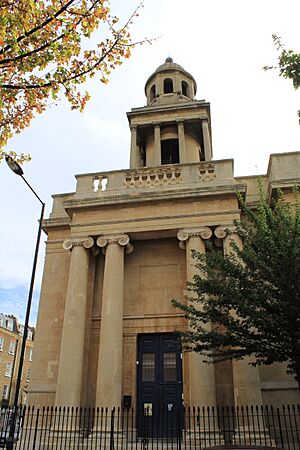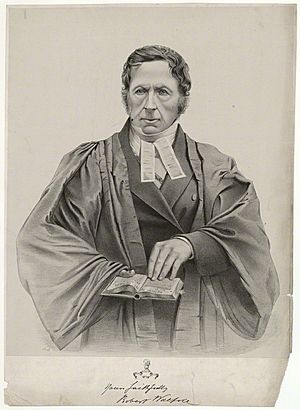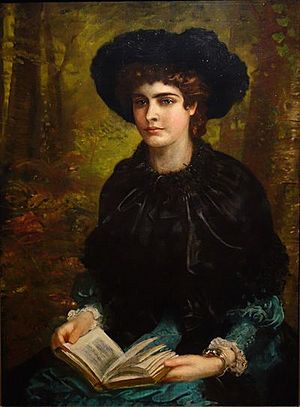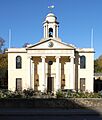Christ Church, Marylebone facts for kids
Quick facts for kids Former Christ Church, Marylebone |
|
|---|---|
| Greenhouse Centre | |
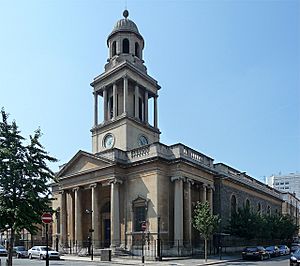 |
|
| 51°31′18″N 0°9′59″W / 51.52167°N 0.16639°W | |
| Location | 35 Cosway Street, Marylebone, Westminster |
| Country | England |
| Denomination | Church of England |
| History | |
| Status | closed |
| Dedicated | 1825 |
| Architecture | |
| Architect(s) | Thomas Hardwick Philip Hardwick |
| Style | Neoclassical |
| Years built | 1822–1824 |
| Closed | 1977 |
Christ Church, Marylebone is a historic building in Marylebone, London. It was once a Church of England church, built in the 1820s. The church is also known as Christ Church, Lisson Grove or Christ Church, Cosway Street. It was designed by architects Thomas Hardwick and Philip Hardwick.
This building is considered very important, so it has a special status called "Grade II* listed." After it stopped being a church in 1977, it was used as an antiques market and a restaurant. Today, it is a busy sports centre called the Greenhouse Centre. You can find it on a lively street between Paddington Station and Regent's Park.
Contents
A Look Inside the Church Building
Christ Church was one of the first "Commissioners' churches." These were about 600 new churches built between the 1820s and 1850s. The British Parliament provided money to build them. This was to help serve the many people moving into new areas around cities.
The church is built in a style called Neoclassical, which means it looks like ancient Greek or Roman buildings. It is covered in light-coloured limestone. Inside, the main part of the church, called the nave, is made of brick. At the front, there is a grand entrance with four tall pillars. These pillars are in the Ionic order style, which means they have scroll-like decorations at the top. Above the pillars is a flat, triangular section called a pediment. There are also pairs of pillars on the sides of the church.
A square tower rises above the church. It has clock faces and more pillars, but these are in the Corinthian order style, which means they have fancy leaf-like decorations. On top of the tower is an eight-sided dome-like structure called a cupola, with a roof shaped like a bell.
Inside, the church has a series of arches supported by pillars, forming an arcade. There are also flat, decorative pillars, called pilasters, on the east wall. Windows high up on the walls, called Clerestory windows, let in light. The nave has a low, arched ceiling with decorative ribs and oval panels. The church also has galleries, which are raised seating areas.
Unlike many older churches, Christ Church did not have a graveyard. Instead, it had a large underground vault for burials. In 1887, some changes were made to the church's design by Sir Arthur Blomfield.
From Church to Sports Centre
The church stopped being used for services in 1977. The building was then sold and changed in the 1980s. It first became a market for old items and a restaurant.
In 2014, a charity called Greenhouse Sports bought the building. This charity helps young people through sports. With support from various groups like Sport England Lottery and the London Marathon Charitable Trust, the building was renovated. The underground crypt (a basement area) was turned into changing rooms and meeting spaces. The new sports centre, named the Greenhouse Centre, was officially opened on April 30, 2018. Prince William, Duke of Cambridge, and Prince Harry attended the opening.
The Church's Community and Leaders
The area around Christ Church became its own parish in 1825. A parish is a local area served by a church. The church also had a special house for its leader, called the Rectory.
George Saxby Penfold was the first Rector (the main priest) of Christ Church. Later, Robert Walpole, a famous scholar, took over.
Over the years, the parish changed. During World War II, parts of the church's buildings were used to house airmen. After the war, the church's parish was combined with others. In 1971, it joined with St Paul, Rossmore Road. Both churches served the new combined parish until Christ Church closed in 1977.
Notable People Connected to Christ Church
Many interesting people have been connected to Christ Church over the years:
- Constance Lloyd, who later became an author and the wife of Oscar Wilde, was baptized here in 1858.
- Arthur Sweatman, who later became an Archbishop in Canada, started teaching at the church's Sunday school in 1850 when he was only fifteen.
- Charles Wheatstone, a famous scientist and inventor, got married at Christ Church in 1847.
- Edward William Cox, a writer and publisher, also married his second wife here in 1844.
Images for kids
See also
- Lisson Grove


